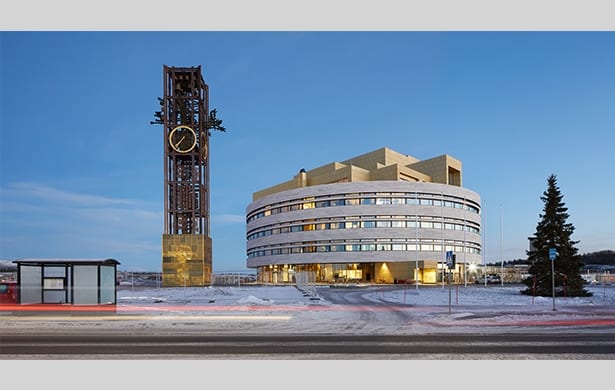 |||
|||
Some 95 miles north of the Arctic Circle, there lies a remote town under threat. Situated in the province of Lapland, Sweden’s northernmost town of Kiruna exists in isolation, with the closest neighbouring town located 75 miles away. Kiruna’s subarctic climate means the sun does not rise for 22 days in December and snowfall can occur year-round. Harsh though it may seem, the climate is however not the main threat to the town’s existence. Mining is.
Kiruna sits atop one of the world’s largest iron ore mines. In fact, the town owes its existence to the management and financing of the Luossavaara-Kiirunavaara mining company (LKAB), which owns the mine and remains Kiruna’s largest employer. Over the years however, miners have burrowed so deep into the earth that the ground has begun to crack, putting the structural stability of Kiruna’s architecture at risk. Studies of these ever-expanding rifts show them creeping closer to the town, putting it at risk of collapse within the century.

In response to this impending threat, LKAB has proposed what might seem like a radical solution straight out of a dystopian movie: move the whole town and its 18,000 citizens 3km east. As such, it anticipates relocating 3,050 houses and nearly 200,000sq m of commercial and civic floor space. In November 2018, the first completed building to kickstart the ambitious £1bn process was the golden-hued Kiruna City Hall.
Designed by Danish architecture practice Henning Larsen and dubbed Kristallen, or “The Crystal”, the building is at once a symbol of the new town and a tribute to the old town’s history. “Demolishing the old Kiruna and moving residents to a fresh city uproots generations of local heritage, interrupting tight-knit neighbourhoods and erasing multigenerational family stores,” the company says. “This relocation is a challenge of identity.”
Historically, design has often proven to be one the best communication tools there is. It often correlates with big questions of image and identity, but how does one preserve entire communities? And where does the balance between innovation and heritage lie? In many ways, Henning Larsen’s golden masterpiece holds the answers.

To preserve the town’s heritage, the practice opted to include the original 1958 bell tower, which now sits on the piazza nearby, and incorporated the door handles from the original town hall designed by Swedish architect Artur von Schmalensee and now slated for demolition. And though it is a physical continuation of Kiruna’s history, The Crystal remains forward-looking.
Open and accessible to all, the new structure’s circular form encapsulates its communal focus. A civic building by function, The Crystal is a community building at heart, and the dual-purpose element of the structure is achieved through distinct inner and outer building volumes. Both circular rings envelop a stack of golden cubes, the shape of which was inspired by the iron ore.
The outer volume houses the town hall’s civic function and staff offices for various municipality departments. The circular glass and natural stone facade also allows for the winter’s heavy snow drifts to glide along and never
settle on the facade.

Meanwhile, the inner core is dedicated to community functions such as a public gallery displaying contemporary art from the arctic region, workshops and social common spaces. “It is a space for old friends and longtime neighbours to meet within the new city centre, supporting a sense of social unity during the transitory period of Kiruna’s relocation,” says Henning Larsen, which designed the building’s circular form to symbolise unity and solidarity.
Located in the heart of new Kiruna, The Crystal’s open-to-all model is in tune with the town’s values and thus becomes a landmark, a role model for a resilient community. With city halls often considered to be the base of a city, Henning Larsen’s Kiruna City Hall takes that definition one step further, building a true foundation for a city yet to be built.
Henning Larsen’s new town hall for the northern Swedish town of Kiruna takes on a very unusual placemaking role


























